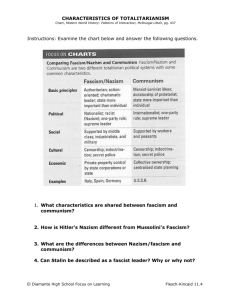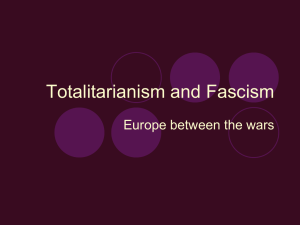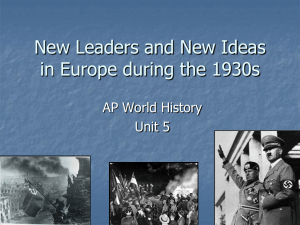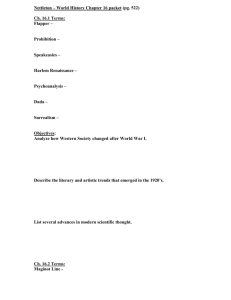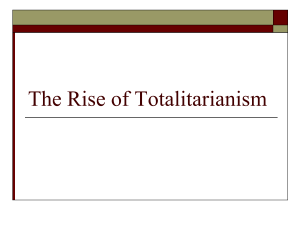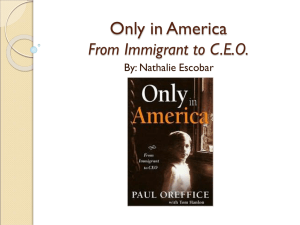Totalitarianism and Fascism
advertisement
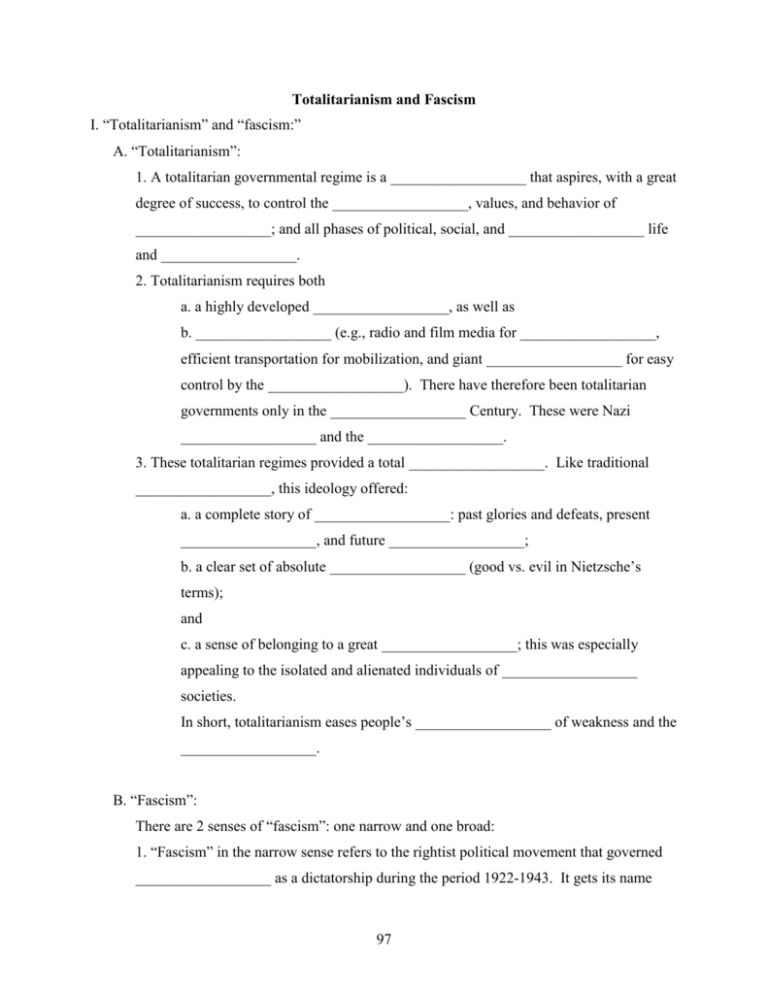
Totalitarianism and Fascism I. “Totalitarianism” and “fascism:” A. “Totalitarianism”: 1. A totalitarian governmental regime is a __________________ that aspires, with a great degree of success, to control the __________________, values, and behavior of __________________; and all phases of political, social, and __________________ life and __________________. 2. Totalitarianism requires both a. a highly developed __________________, as well as b. __________________ (e.g., radio and film media for __________________, efficient transportation for mobilization, and giant __________________ for easy control by the __________________). There have therefore been totalitarian governments only in the __________________ Century. These were Nazi __________________ and the __________________. 3. These totalitarian regimes provided a total __________________. Like traditional __________________, this ideology offered: a. a complete story of __________________: past glories and defeats, present __________________, and future __________________; b. a clear set of absolute __________________ (good vs. evil in Nietzsche’s terms); and c. a sense of belonging to a great __________________; this was especially appealing to the isolated and alienated individuals of __________________ societies. In short, totalitarianism eases people’s __________________ of weakness and the __________________. B. “Fascism”: There are 2 senses of “fascism”: one narrow and one broad: 1. “Fascism” in the narrow sense refers to the rightist political movement that governed __________________ as a dictatorship during the period 1922-1943. It gets its name 97 from the fact that in 1919 their leader, Benito Mussolini (1883-1945) began using the fasces – a bundle of __________________ bound with a red cord that had been used in ancient __________________ as a symbol of authority – as a symbol of his movement. 2. “Fascism” in a broad sense also includes Nazi __________________ (1933-1945), since in both cases power was wielded exclusively by a single, popular, and charismatic __________________ (= “Duce” in Italian; “Führer” in German). C. Totalitarianism and fascism compared and contrasted: 1. Totalitarianism and fascism: a. Both are authoritarian, since the dictator’s or Party’s __________________ are what rule, instead of free and rational __________________ (e.g., through parliament or __________________). b. Both are also absolutist, since they allow no limits on the __________________ of the dictator or the Party. c. Both are against liberal __________________ (e.g., civil rights) and __________________ (e.g., effective parliaments or voting). 2. Unlike Soviet totalitarianism, German and Italian fascism was also opposed to __________________. Whereas Marxism was an __________________ movement, based on an economic class (the proletariat); fascism was a __________________ movement, based on the notion of a people (linked by race or culture). II. The rise of fascism in Italy: Italy immediately after WWI: - After WWI, Italy was ruled by a weak __________________ government. - Italy’s __________________ was in shambles: food shortages, inflation, and __________________. - Italian landowners and industrialists feared a __________________ revolution, as had happened in __________________ in 1917. - Italians felt that they had __________________ much during WWI, but gained little in return from the Peace of __________________. 98 1919: Mussolini, a WWI veteran, organizes the Fascist party, with its own militia of “__________________ Shirts” to combat the socialist “__________________ Shirts”. Mussolini’s Fascist party was supported by: - Italian landowners and industrialists, who supplied __________________; - military __________________, who thought Mussolini would increase Italy’s military power; - the lower-middle class, who feared the power the __________________ promised to factory workers; - intellectuals and university students, who were attracted to Mussolini’s promise of __________________. October 1922: Mussolini’s Fascists march on __________________, demanding power, even though they had only 35 of 535 seats in parliament. The weak liberal King Victor Emmanuel III appoints Mussolini __________________ to __________________ them. 1925-6: Mussolini eliminates non-Fascists from his __________________, dissolves opposition __________________ and trade unions, censors the __________________, puts Fascists in local government, and organizes a __________________ secret police. - Once firmly in power, Mussolini used the __________________ to convey an image of himself as a macho leader who would restore the glory of the __________________ Empire to Italy. - In order to make Italy self-sufficient (in case of war), Mussolini - launched the “battle of __________________” to increase the wheat crop; - limited the import of __________________ goods, which increased the profits for Italian industrialists. 1929: the Lateran Accords recognize the independence of __________________ City, and made __________________ instruction mandatory in all secondary schools. This was Mussolini’s attempt to secure the support of the ultra__________________ Pope Pius XI (r. 1922-29), and thus to improve Mussolini’s image among __________________. 99
